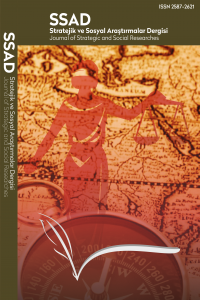OSMANLI'DAN CUMHURİYET'E TÜRKİYE'DE RUMLARIN İDARESİ
Rumlar, Osmanlı Devleti’nde hem nüfus olarak en kalabalık hem de devletle ilişkileri itibariyle en güçlü gayrimüslim toplumdu. İstanbul’un fethi sonrası patrikhanenin statüsünün tanınmasıyla birlikte Rum milletinin idaresi patrikhane merkezli olarak tesis edilmişti. Toplum üzerinde etkili olan temel otorite patrikhaneydi. Tanzimat döneminde yaşanan kısmî değişimle birlikte patrikhane Osmanlı Devleti’nin sonuna kadar toplum üzerindeki statüsünü korumuştu. Ancak özellikle mütareke döneminde yaşananlar devletle patrikhane arasındaki ilişkileri gerginleştirdiği gibi Rum milletinin patrikhaneyle ilişkilerine de etki etmişti. Buna rağmen Rumlar, Osmanlı Devleti’nde olduğu gibi Cumhuriyet’e geçiş ve sonrasında da yaşanan birçok olaya rağmen nüfus ve nüfûz itibariyle gayrimüslim topluluklar içerisinde en güçlü olan gruptular. Bununla birlikte Türkiye Cumhuriyeti’nin azınlık politikalarında en fazla problem ve çatışma yaşadığı azınlık toplumu da yine Rumlar olmuştu. Bu durumun temel sebebi de mütareke döneminde yaşananlardı. Mütareke döneminde yaşananları sonraki süreç açısından da yaşanabilir bir tehdit olarak gören devlet azınlık politikalarında sert bir tutum belirlemişti. Bu çalışmada Rum toplumunun Osmanlı dönemindeki idari yapılanması ve Cumhuriyet sonrası bir azınlık toplumu olarak konumu incelenecektir.
Anahtar Kelimeler:
Rum, Patrikhane, Lozan Antlaşması, Azınlık
Administration of Rum Community from the Ottoman State to the Republic of Turkey
The Rums were both the most populous and the strongest non-Muslim society in the Ottoman State in terms of their relations with the state. With the recognition of the status of the patriarchate after the conquest of Istanbul by the Ottoman State, the administration of the Rum community was governed by the patriarchate. Thus, The main authority that had influence on the society was the patriarchate. Despite the partial change during the Tanzimat period, the patriarchate maintained its status over the community until the end of the Ottoman State. However, what happened during the armistice period not only strained the relations between the state and the patriarchate, but also affected the relations of the Rum community with the patriarchate. Nevertheless, the Rums were the strongest group among the non-Muslim communities in terms of population and influence, despite the many events that took place during and after the transition to the Republic, as it was in the Ottoman State. However, the community in which the Republic of Turkey had the most problems and conflicts in terms of minority policies was again the Rums. The main reason for this was what had experienced during the armistice period. Seeing what happened during the armistice period as a recurring threat in the future, the state had taken a tough stance in its minority policies. In this study, the administrative structure of the Rum society in the Ottoman period and its position as a minority society after the Republic will be examined.
Keywords:
Rum, Patriarchate, Lozan Treaty, Minorities,
___
- AKGÖNÜL, Samim, Türkiye Rumları: Ulus-Devlet Çağından Küreselleşme Çağına Bir Azınlığın Yok Oluş Süreci, (Çeviren: Ceylan Gürman), İstanbul 2007, İletişim Yayınları.
- AKTAR, Ayhan, Varlık Vergisi ve Türkleştirme Politikaları, İstanbul 2000, İletişim Yayınları.
- ALEXANDRIS, Alexis, The Greek Minority of Istanbul and Greek-Turkish Relations 1918-1974, Athens 1992, Centre for Asia Minor Studies.
- ANZERLİOĞLU, Yonca, Karamanlı Ortodoks Türkler, Ankara 2003, Phoenix Yayınları.
- ATALAY, Bülent, Fener Rum Patrikhanesi’nin Siyasi Faaliyetleri (1908-1923), İstanbul 2001, Tarih ve Tabiat Vakfı (TATAV) Yayınları.
- AUGUSTINOS, Gerasimos, Küçük Asya Rumları – 19. Yüzyılda İnanç, Cemaat ve Etnisite, (İngilizceden Çeviren: Devrim Evci), İstanbul 2011, Dipnot Yayınları.
- BAŞ, Mustafa, Türk Ortodoks Patrikhanesi, Ankara 2005, Aziz Andaç Yayınları.
- ISSN: 2587-2621
- Yayın Aralığı: Yılda 3 Sayı
- Başlangıç: 2017
- Yayıncı: Mehmet Ali KARAMAN
Sayıdaki Diğer Makaleler
BODRUM'DAKİ GİRİTLI TÜRKLERİNİN SÖZLÜ HATIRALARI VE GİRİT KİMLİĞİ
OSMANLI'DAN CUMHURİYET'E TÜRKİYE'DE RUMLARIN İDARESİ
GÜNÜMÜZ YUNANİSTAN’INDA MÜSLÜMAN KARŞITI NEFRET VE AYRIMCILIĞI YENİDEN DÜŞÜNMEK
NÜFUS MÜBADELESİ VE BATI TRAKYA TÜRKLERİ
ONTOLOJİK GÜVENLİK BAĞLAMINDA TÜRK[İYE]-YUNAN[İSTAN] ÇATIŞMASI
